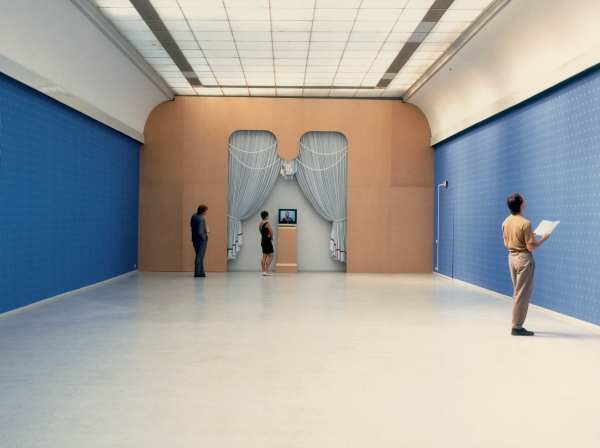
Installation view, Room VI, Arti et Amicitiae, Amsterdam, 1988
Installation view, Room III, Arti et Amicitiae, Amsterdam, 1988
“Eh! bien pronouns la plume,” 1988, artist’s book
Room III in the 19th century, etching c. 1880.
Lawrence Weiner, sketch, 1988
Eh! bien prenons la plume
3 – 24 September 1988
Arti et Amicitiae, Amsterdam
Rooms I, II, III, VI, VII:
Wallpaper with silver motifs of St. Luke on a blue background
Room III:
– “The King’s Welcoming Speech,” 1988, monitor and video on base, 3 min.; Sammlung Karola Grässlin
– Reconstruction of the original architecture in MDF, curtain fabric
Room VI
– Architectural intervention in wood, painted
– Group picture (gift of 15 Arti et Amicitiae members to King Wilhelm III, 1874)
– Bench by Hendrik Petrus Berlage, 1893
Stairway / Club Rooms:
– Site-specific works by new Arti et Amicitiae members: Fortuyn/O’Brien, Aldert Mantja, Rob Scholte, Ton van Summeren, Martin van Vreden, Peer Veneman
Artist's Book:
– Eh! bien prenons la plume, 1988, 96 pages; 6.5 x 9.5 inches, edition of 1000
Müller was invited by Arti et Amicitiae, located in Amsterdam at Rokin 112, to curate the annual exhibition of work by new members. Arti et Amicitiae was founded in 1839 as an artists’ union, to provide them with a social setting and an exhibition venue and thereby with an infrastructure of their own. The title of the exhibition echoed the founding motto. In 1852, the association donated a Rembrandt monument to the city, making it clear that they existed not only to secure their own financial interests, but above all to enhance their artistic prestige. In 1874, in honor of the twenty-fifth anniversary of his reign, they presented King Wilhelm III with multiple collections of small pictures in heavy gold frames; these 15-piece sets of miniatures were intended to demonstrate the abilities of the Arti et Amicitiae artists and offer the king an opportunity to acquire the large-scale originals. Though successful in a time of monarchy and national history painting, the institution later experienced a period of crisis. As an association of members, the character of the institution changed with the successive generations and the private and public events they organized.
In 1987, Thomas Meyer zu Schlochtern was appointed as the first artistic director in an effort to give Arti et Amicitiae a clearer exhibition profile. The following year he invited Christian Philipp Müller to curate the presentation of the 39 new members, among them Lawrence Weiner, Rob Scholte, and Jacqueline de Jong. Müller conceived the exhibition at Arti et Amicitiae as a tour of the building and its history and an invitation to the new members to create site-specific works for the transitional spaces, clubroom, and library. The works by members were shown in the clubrooms of the building, spaces accessible primarily to the members themselves; the actual exhibition area was used for a presentation of the institution’s history.
Both parts of the exhibition were accompanied by a specially produced artist’s book in which Müller retold the history of Arti et Amicitiae through his own visit as a tourist to the city and the building with its clubrooms, library, and bar. An appendix to the publication, designed in the organization’s own historic typography, listed the new members and reproduced samples of their work. On the second floor of the building, Müller used historical illustrations of the institution to develop a presentation of the repeatedly remodeled exhibition spaces. All the white walls on the second floor were covered in royal blue wallpaper; the silver patterning consisted of variations on the club logo of the Guild of St. Luke from 1839 and its contemporary, abstracted version of 1988. Partition walls enclosed the chambers and divided the second floor into two wings. In one wing the sample miniatures of 1874 were exhibited, by which the 15 artists had demonstrated their skill to the king and solicited his patronage. These works are still in the collection of the royal family today. In the other wing, Müller displayed the video “The King’s Welcoming Speech” on a pedestal in front of a stately curtain. In the video, Müller himself appeared in royal costume and spoke directly to both new members and exhibition visitors about his personal relationship to Arti et Amicitiae.



